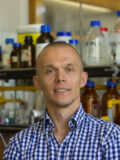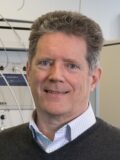Projects
Principal Investigator
Prof. Dr. Andreas Hirsch
91058 Erlangen
- Phone number: +49 9131 85-65581
- Email: andreas.hirsch@fau.de
- Website: https://www.oc2.chemistry.nat.fau.eu
Project Focus
Project A1 is devoted to the development and basic understanding of the principles of synthetic carbon allotrope (SCA) chemistry. Here, fullerenes, single walled carbon nanotubes, and graphene are providing the basis for our investigations. The systematic exploration of SCA reactivity is closely connected with the synthesis and quantitative characterization of both covalent and non-covalent SCA derivatives. In collaboration with project partners from all research areas of the SFB 953, suitable SCA derivatives will be further investigated by quantum-mechanical calculations, characterized in more detail with respect to their physical properties, and incorporated into electronic and optical devices. In the first funding period, many fundamental results of covalent and non-covalent SCA chemistry such as hydrogenations, regioselective addition of organic addends, formation of hybrid architectures, and many more, were generated. Moreover, basic analytical tools, that allow for the first time a representative, efficient, and quantitative characterization of carbon nanotube and graphene derivatives, have been introduced. In the second funding period, we will continue and extend our studies on quantitative SCA chemistry. In addition, we will target a variety of innovative aspects stemming from our results and unexpected discoveries of the first funding period. In particular, we will carry out a comparative exploration of SCA chemistry where we will study the influence of the nature of the SCA building block, its topology and arrangement (e.g., dispersed or surface supported monolayer, bilayer, etc.) on its reactivity (WP-1-A). We will synthesize a series of functional covalent SCA derivatives (WP-1-B) where additional properties such as redox- and photo-activity, receptor-complementarity, and switching are introduced. Furthermore, we will develop a series of new reactions, using both neutral and negatively charged SCAs as starting materials (WP-1-C). This will include compound classes such as SCA halogenides, carboxylates, sulfonates, phosphonates, and Lewis-acid adducts. A very important focus will be the systematic investigation of the underlying reaction mechanisms of covalent SCA adduct formation (WP‑1‑D), in particular those of carbon nanotubes and graphene. The studies will be carried out on the basis of our newly developed analytical tools such as scanning Raman spectroscopy (SRS), scanning Raman microscopy (SRM), and TGA/MS/GS. Moreover, we will receive fundamental support from our project partners contributing, for example, quantum mechanical calculations and transport measurements. The next major work package is dealing with non-covalent SCA chemistry. Here, we will use the very large library of amphiphilic rylenes and related compounds, which we have synthesized in the first funding period for the dispersion of SCAs in water (WP-2-A). In addition, we will carry out systematic supramolecular chemistry studies in order to reveal major non-covalent driving forces in SCA assembly (WP-2-B). These investigations will bring us in the position to construct hierarchically-ordered hybrid architectures as novel 2D- and 3D-materials (WP-2-C). Finally, we will develop for the first time a new field in materials science, which at the same time constitutes one focal topic (All-Carbon Architectures) within the SFB 953, namely the investigation of inter-SCA architectures ( WP-3). Our aim is to synthesize SCA building blocks (WP-3-A) equipped with a suitable vehicle allowing for the successive assembly of these All-Carbon Architectures (WP‑3‑B). These materials are of interest for their own right since tailored functions can be generated. However, they can also serve as versatile precursors for the generation of parent inter-SCA architectures consisting of only carbon.
Principal Investigator
apl. Prof. Dr. Norbert Jux
91058 Erlangen
- Phone number: +49 9131 85-65583
- Email: norbert.jux@fau.de
- Website: http://www.jux.chemie.nat.fau.de/
Project Focus
The porphyrin macrocycle acts as a molecular platform to construct graphene-like carbon networks. Annulated pyrroles such as isoindoles and aryl aldehydes, including acetylenic derivatives, will form highly substituted carbon-rich porphyrin systems. C-C bond formations such as oxidations supported by Lewis acid catalysis, palladium-catalyzed cyclizations, or flash vacuum pyrolysis, will be utilized. Most members of this new family of compounds, the graphyrins, will form bowl-shaped structures because of the five-membered pyrrole rings. This may give rise to interesting electronic properties, as well as to supramolecular interactions, with, for example, fullerenes, or packing motifs. The coordination of metal ions by the porphyrin’s N4 core will give access to novel materials. Ligand binding to the central metal may prevent p-p-stacking of carbon sheets. Substituted hexabenzocoronenes (HBCs) will be made and functionalized, yielding electronically modulated graphene model systems. Collaborations include photochemical and -physical studies, surface chemistry, mass spectrometry and theory.
Principal Investigator
Prof. Dr. Wolfgang Peukert
Cauerstraße 4
91058 Erlangen
- Phone number: +49913185-29400
- Email: wolfgang.peukert@fau.de
- Website: http://www.lfg.uni-erlangen.de
Project Focus
We will design advanced and scalable synthesis methods for carbon nanodots (CNDs) and single wall carbon nanotubes (SWCNTs) and will finalize the studies on graphene production by graphite delamination. The solvothermal CND formation mechanisms and dynamics will be studied by in situ spectroscopic methods. The produced CNDs will be size-selected and their structure will be carefully characterized, e.g., by a unique combination of Electrospray-Differential Mobility Analysis-Mass Spectrometry and by Multi Wavelength Analytical Ultracentrifugation (MWAUC). SWCNTs will be synthesized in a fluidized bed reactor utilizing tailored non-ferromagnetic catalysts to allow separation of metallic and semiconducting SWCNTs by controlled binding to magnetic nanoparticles after selective functionalization. In addition, we will design synthesis processes for hybrids of carbon allotropes and nanoparticles by wet-chemical methods and surface-assisted growth from the gas phase. For the characterization of the carbon allotropes and their hybrids regarding size and shape, defects as well as functional groups, our already strong tool box will be further expanded, e.g., by new evaluation methods for MWAUC. Interactions of carbon allotropes with nanoparticles will be studied in cooperation with project partners in the SFB 953 for magnetic separation of SWCNTs and in order to tune the electronic, optical and catalytic properties of the hybrid materials for potential applications in solar cells, fuel cells, batteries or in catalysis.
Principal Investigator
Prof. Dr. Rik Tykwinski, PhD
Alberta
Canada
- Phone number: 001-780-492-9529
- Email: tykwinsk@ualberta.ca
- Website: https://www.ualberta.ca/science/about-us/contact-us/faculty-directory/rik-tykwinski
In 2016 Prof. Tykwinski received a call from the University of Alberta.
Project Focus
The research outlined in this proposal will synthetically extend Nature’s diversity beyond the known 0-, 1-, 2-, and 3-dimensional carbon allotropes, such as fullerenes, nanotubes, graphene, and diamond. We will accomplish this through the design and rational synthesis of molecules that allow us to explore and predict the properties of new allotropes of carbon, namely carbyne, graphyne, and graphdiyne. In each proposed project, the development of new synthetic methods is the starting point. Synthesis leads to new molecules that provide the direct link between our work and other groups in SFB 953 who conduct physical characterization and those who offer theoretical understanding.
We have already synthesized monodisperse polyyne oligomers of unprecedented length and/or function based on sp-hybridized carbons toward developing an understanding of the 1-dimensional carbon allotrope, carbyne. Now we focus on cumulenes, the other potential form of carbyne, and the proposed work will produce cumulenic molecules to serve as model compounds. Analysis of structure-property relationships will be key to uncovering the potential properties of this carbon form of carbyne. Crucial factors to be determined by this study are the physical, electronic, and optical differences between polyyne and cumulene carbyne. On the other hand, it is also possible that the properties of these two carbynes might merge at some undetermined length, and we would thus discover that polyyne and cumulene carbyne are actually the same material. Fundamental properties of polyynes and cumulenes will also being determined, for example, by gas-phase MS/MS experiments, ultrafast spectroscopy, surface analysis, and theory.
The direct synthesis of polyynes endcapped with groups such as pyridines, pentacenes, and porphyrins has been established in the 1st funding period, with a goal to use these molecules in all-carbon devices. Studies will be pursued to further develop and optimize these materials, as well as the analogous cumulenes, for use as molecular wires for attachment to break-junction electrodes.
We will continue our efforts to synthesize the “enyne” carbon allotropes graphyne and graphdiyne. Our studies of carbon-rich macrocycles and ladder oligomers as substructures of graphyne are both closely linked and guided by theory, which helps us to target the most electronically interesting structures and to understand the properties that are determined (i.e., redox, optical, and electronic differences versus structure). In a very forward-looking effort, we have made remarkable progress in the synthesis of small molecule precursors for constructing graphdiyne, and we will use these building blocks for synthesis of graphdiyne films on the surface metals or even graphene.
Principal Investigator
Prof. Dr. Milan Kivala
Nikolaus-Fiebiger-Str. 10
91058 Erlangen
- Phone number: +49 9131 85-65571
- Email: milan.kivala@fau.de
- Website: https://chemistry.nat.fau.eu/kivala-group/
Project Focus
The focal point of this project is the synthesis of unprecedented polycyclic aromatic hydrocarbons (PAHs) selectively doped with nitrogen and phosphorus starting from rationally designed precursor molecules allowing to vary the size, shape, and periphery of resulting PAHs. Such sp2-carbon scaffolds are intriguing research targets for both experimental and theoretical studies as they are predicted to act as defined molecular fragments of heteroatom-doped carbon allotropes. The efficient electronic communication between the heteroatom and the surrounding p-system will result in strongly altered optoelectronic and materials properties when compared to their all-carbon counterparts which makes these compounds also potentially interesting as functional materials for application in organic electronics.
In particular the field of phosphorus-doped PAHs is still in its infancy although such compounds often show different properties from their nitrogen analogues. Moreover, the Lewis-basic phosphorus provides the opportunity for further chemistry to modulate the properties of the entire p-system. Building on our expertise in organophosphorus chemistry we will contribute to this young research area and push the limits of PAH chemistry in general. On the fundamental side we will aim at unraveling the parallels and differences between the chemical and optoelectronic properties of analogous N- and P-doped sp2-carbon scaffolds.
Next to various cyclodehydrogenation protocols in solution we will systematically explore the possibilities provided by flash vacuum pyrolysis (FVP). The immense potential of the FVP method for the synthesis of so-called geodesic polyarenes has been demonstrated in the past. In this context it is even more surprising that only little is known about its general applicability for related heteroatom-containing systems. In collaboration with physicists surface-assisted reactions followed by scanning probe microscopy will be used to fabricate highly ordered heteroatom-doped carbonaceous networks from carefully designed precursors.
While the proposed research program is situated at the very center of modern synthetic organic chemistry, it will succeed only when embedded within the established network of highly interdisciplinary collaborations provided by the Collaborative Research Center (SFB) platform.
Principal Investigator
PD Dr. Konstantin Amsharov
91054 Erlangen
- Phone number: +49913185-22544
- Email: konstantin.amsharov@fau.de
- Website: http://www.hirsch.chemie.uni-erlangen.de/en/hirsch-group/konstantin-amsharov.html
Project Focus
The possibility to “tune” electronic properties of Single-Walled Carbon Nanotubes (SWCNTs) in wide range makes SWCNTs very promising candidates for various potential applications. The realization of these applications has however remained elusive due to a lack of efficient production techniques for fabrication of single-helicity SWCNTs. Previously we have demonstrated that isomer pure fullerenes and buckybowls can be synthesized very effectively by surface assisted cyclodehydrogenation (SACDH) utilizing specially designed precursor molecules. Further, we have shown that the approach can be extended to the fabrication of CNT-caps and ultra-short singly-capped SWCNTs. Finally we were able to demonstrate that respective CNT seeds can be effectively elongated to the isomer pure SWCNTs. This finding shows general possibility of the fabrication of helicity pure and defect free SWCNTs in a fully controllable manner. Our recent progress in the synthesis of isomerically pure and defect free (6,6) armchair SWCNT by Pt assisted strategy under STM (Scanning Tunneling Microscopy) condition is a fundament for this proposal. The main goal of the project is to create and establish a reliable synthetic pathway for facile preparative fabrication of helicity pure and defect free SWCNTs. The results obtained define the way to the preparative fabrication of isomer pure SWCNTs of virtually any desired chirality. According to our preliminary investigation the production of these unique materials in bulk amounts does no longer appear elusive. In our project, by exploiting the same pathway we expect to find experimental conditions which will provide an access to highly interesting isomerically pure carbon nanotubes. Of particular interest are here the investigation of the influence of the cap structure (including size, chirality and periphery geometry) and the surface used (different metals, different morphology) on the efficiency of SWCNT production (yield, quality, scalability). The synthesis route to metallic arm-chair and zig-zag nanotubes of various diameters as well as semiconducting tubes and functional CNTs (which includes precursor synthesis, CNT cap fabrication and SWCNT growth) planned to be developed. The project is subdivided into three work packages (WPs). Although the activities of each WP can be run parallel, all WPs are strongly interconnected. Thus the current progress in one WP will inspire the development of the other and vice versa. The focus of the WP-1 lies on the synthesis of precursors for various helicities and investigation of factors that influence the efficiency of SWCNT fabrication. The transformation of the respective precursors to the single-helicity ultra-short CNTs and the following epitaxial elongation will be investigated by means of STM technique. Synthesis of functional SWCNT bearing a porphyrin functionality is subject of WP-2 where a synthesis of porphyrin based precursor molecules plane to be developed. Further following the same approach it is planned to synthesize porphyrin containing related structures such as fullerene-like system and carbon nanocones. The respective functional carbon-based nanostructures (bearing porphyrin moiety) are excellent candidates for many nano-technological applications and can be used further for rational construction of complex CNT based architectures. The activities of WP-3 will be focused on the adaptation of the surface assisted fabrication technique for bulk CNT production using common CVD (Chemical Vapor Deposition) approach. In the course of this project, the knowledge necessary for design of highly effective SWCNT precursors and the condition for efficient SWCNT fabrication will be obtained.
Principal Investigator
We could not find any entry with the given search term 21082.
In 2016 Prof. Max von Delius received a call from the University of Ulm.
Project Focus
In this project, we propose the synthesis of novel, mechanically interlocked materials based on two types of synthetic carbon allotropes (SCAs): carbon nanotubes and fullerenes. Mechanically interlocked architectures (MIAs) are assemblies of two or more molecular entities, which are held together not through covalent or non-covalent bonds, but rather as a consequence of their topology. Despite their unique dynamic properties and application prospects, MIAs based on synthetic carbon allotropes are still underexplored.
In work package 1 (WP-1), we plan to use the reversible formation and breakage of disulfide bonds for the assembly of macrocycles around single-walled carbon nanotubes (SWCNTs). The nanotube will thus serve as a template for the formation of the rings and the final product will be a polyrotaxane, in which a large number of small molecular rings are wrapped around the nanotube. While a proof-of-principle for the formation of such SWCNT-MIAs was recently demonstrated by a group in Spain,[1] our approach differs fundamentally, because we will close the molecular rings under thermodynamic control (higher yields expected) and water can be used as a solvent. The planned experiments will deliver solution-processable nanotubes that are persistently functionalized, but have a completely intact sp2-framework.
In work package 2 (WP-2), we propose the synthesis of the first rotaxanes featuring a fullerene as supramolecular binding site. The target compounds are dumbbell-shaped MIAs that consist of an axle featuring a central fullerene trans-bisadduct (to act as binding site) and two suitably functionalized fullerenes (to act as bulky stoppers), as well as macrocycle [10]cycloparaphenylene ([10]CPP). In the final rotaxanes, the [10]CPP ring is free to shuttle back and forth along the axle, which we expect will result in unusual molecular properties.
Multiple collaborations will be the key to the success of both work packages: the design of the building blocks will be guided by molecular modelling (collaborations with Research Area C), the prepared materials will require extensive characterization efforts (collaborations with Research Area Z) and physicochemical as well as device studies (collaborations with Research Area B) will pave the way towards possible applications. Most of the research proposed herein would not be feasible without the outstanding research infrastructure in Erlangen and the excellent platform for scientific networking that this SFB provides.
Principal Investigator
Prof. Dr. Christoph J. Brabec
91058 Erlangen
- Phone number: +49913185-25426
- Mobile phone: 01717557762
- Email: christoph.brabec@fau.de
- Website: http://www.i-meet.ww.fau.de/
Project Focus
This research proposal aims to design, characterize and investigate the opto-electronic properties of All-Carbon Architecture hetero-junctions (HJs). HJs are, besides the p-n junctions, the most frequently engineered junctions for opto-electronic applications with intrinsic semiconductors.
Carbon-based devices offer several attractive features for use in next-generation electronics, like the abundance of carbon, their potential cost advantage and their rather energy efficient production in large quantities. Firstly, that potential is best reflected by the fact that the production of carbon nanotubes, graphene and fullerenes has increased exponentially over the past several years as new methods and processes are becoming available, improving both, scalability and costs.[1,2] Second, most of the carbon allotropes can be dispersed and deposited by solution processes and potentially will be processed by printing and coating methods such as common in roll-to-roll manufacturing.[3,4] Third, today´s advanced synthetic methods allow to permanently tune and improve the electronic and optical properties of this class of semiconductors enabling the development of novel architectures and functionalities for many different types of devices such as for transistors, solar cells, displays, and supercapacitors but also completely novel devices.[5-7] Finally, due to the absence of heteroatoms, carbon allotropes may have an excellent long-term chemical, photochemical and thermal stability, potentially unmatched by any other representative of the p-conjugated semiconductor classes.[8-11]
The focus of the first research period of project B1 was on “conjugated polymer – carbon allotrope“ hetero-junctions. Novel additive based processing methods for polymer – fullerene composites (Topic A, 1st period) and novel fullerenes with various dimensional architectures (Topic B, 1st period) were developed and investigated over the last 4 years, with the aim to (i) gain better topological control on the HJ formation and (ii) to correlate the specific microstructures and microstructure defects with the performance of thin film photovoltaic devices. Utilizing the know-how and knowledge gained from this 1st period and the methods developed therein, we now suggest to investigate and start controlling microstructure formation in All-Carbon Architecture hetero-junctions. More precisely, in the second period we will concentrate on engineering and investigating All-Carbon Architecture HJs, with a strong focus on single wall nanotube (SWNT)–fullerene as well as graphene(G1)–fullerene composites. Such All-Carbon Architecture bulk (HJ) composites have the potential to act as a charge generation center but also as a charge emission layer in opto-electronic devices like solar cells, photodetectors or light emitting diodes. Various architectures will be investigated, such as simple dispersions of SWNT with fullerenes and controlled interface formation by solvent-assisted diffusion of fullerenes into SWNT assemblies. Nevertheless, the clear focus will be placed on p-p solubilized hetero-composites of SWNT or graphene blended with fullerenes. Project B1 will contribute to further thrive the field of All-Carbon Architecture devices by developing better device architectures with improved materials, enhanced performance and prolonged stability, supporting to transfer the basic science into novel devices and applications.
We will put strong emphasis on building the relation between the solid state microstructure and the bulk properties of All-Carbon Architecture composites. The more fundamental scientific challenges are to investigate and manipulate (i) the microstructure formation of heterojunction composites and (ii) to understand their resulting opto-electronic bulk properties, especially their ambipolar charge transport mechanisms as a function of the component´s molecular design. The application oriented challenges are (iii) understanding the charge generation and charge recombination mechanisms in All-Carbon Architecture composites as relevant in devices like solar cells or lighting elements and (iv) exploring the environmental stability of All-Carbon Allotrope composites. Finally, (v) will be exploring novel carbon allotropes from this consortium for innovative HJ applications.
While reports exist on the conductivity of single s- or m-SWNTs or graphene flakes, little is known about the electronic transport in application relevant thin films. Single-tube or single flake transport studies yield idealized transport parameters that may not be applicable to thin film geometries as relevant for macroscopic devices. In a thin film, transport will be affected by interfaces and distances between molecules or nanoparticles and also the optical properties are expected to show significant differences from single tube or single flake studies.
Principal Investigator
Prof. Dr. Marcus Halik
91058 Erlangen
- Phone number: +49913185-27732
- Email: marcus.halik@ww.uni-erlangen.de
- Website: http://www.omd.uni-erlangen.de
Project Focus
In the first funding period we have developed methods for the defined 2D self-assembly of functionalized SCAs and we have characterized their electrical properties in device architectures. The self-assembly from solution has been demonstrated for 0D-fullerenes, 1D-SWCNT and 2D-graphene with monolayer thickness control to enable integration in thin-film devices. The self-assembly of surfaces with region-selectivity was realized by dedicated interaction of SCAs with self-assembled monolayers (SAMs), serving attractive or repulsive interaction. Besides the proof of concept we have investigated the impact of either the functionalization of the SCAs and the SAM layer to the electrical properties. Structure-property relations related to transport phenomena and order have been shown in devices and theory. So far we focused on defined thin-film of one particular SCA (2D system) to develop fabrication- and characterization methods and to create the corresponding theory tools.
In the second funding period we plan to develop methods for a defined 3D-assembly of functional SCAs as key enabler for prospective All-Carbon Architectures for electronics. We will follow two concepts, were the first targets a layer-by-layer assembly of functionalized allotropes with covalent (e.g., click chemistry) or non-covalent (e.g., Coulomb forces) driving forces. This is a main approach relates to the focal topic of the SFB 953 which uses Chemistry on Surfaces. The second approach based on a concerted 3D-assembly of particular functionalized SCAs via nano-phase separated block-copolymer (BCP) matrix support. Here we try to match the surface energy of on particular phase of the BCP by functionalization of the SCAs to address the BCP-phase selectively and to create periodic structures on nanoscale by treating the BCP.
Principal Investigator
Prof. Dr. Sabine Maier
91058 Erlangen
- Phone number: +49913185-27268
- Email: sabine.maier@physik.uni-erlangen.de
- Website: http://www.pi3.physik.uni-erlangen.de/maier/
Project Focus
In the first funding period, project B4 focused on the self-assembly and on-surface linking of heteroatom-doped polycyclic aromatic hydrocarbons (PAHs) on surfaces as well as on a molecular level study of functionalized graphene. We studied highly-ordered homomolecular and bimolecular self-assembled networks of heteroatom-doped PAHs on metal and insulating surfaces using scanning probe microscopy (SPM). We gained a profound understanding of their topographic and electronic structure, chemical stability and charge transfer effects. In addition, we succeeded to produce highly ordered covalently-linked two-dimensional (2D) porous networks, wires and macrocycles on coinage metal surfaces through Ullmann-type coupling. The heteroatom-doped 2D-networks can be considered as unprecedented prototypes of doped porous graphene. Related to the non-covalent functionalization of supported graphene, we identified the adsorption probability of water molecules in dependence of the graphene thickness on SiC. In collaboration with B7 Steinrück/Papp we grew Pd clusters with a well controlled size distribution on graphene/Rh and determined their structural properties and thermal stability. Further, we analyzed the intercalation mechanism of hydrogen on graphene/SiC at a local scale in collaboration with B8 Weber.
In this proposal, we aim at producing surface supported carbon allotropes and at understanding their growth, structure, electronic and mechanical properties at the atomic scale using scanning probe microscopy and spectroscopy. In the focus are in particular the on-surface synthesis of graphyne (WP-1), heteroatom-doped graphene-like networks and nanoribbons (WP-2) as well as nanocones (WP-4). These experiments will greatly contribute to the focal topic Chemistry on Surfaces and will be in close collaboration with Research Area A providing us with taylor-made molecular building blocks and Research Area C supporting our experiments with DFT calculations on structural aspects and the reaction energetic. In addition, we continue the study on the functionalization of graphene (WP-3). In particular we concentrate on the non-covalent functionalization of graphene through the adsorption of PAHs. A structural study of the self-assembly along with a spectroscopic study by scanning tunneling spectroscopy will exploit the influence of the PAHs as doping networks for graphene. These experiments provide valuable insights for All-Carbon Architectures.
Principal Investigator
Prof. Dr. Paul Müller, Dr. Yuri Koval
About
Prof. Dr. Paul Müller reitred in 2015.
Principal Investigator
Prof. Dr. Thomas Seyller
Affiliation: Technische Universität Chemnitz, Institut für Physik, Reichenhainer Straße 70, 09126 Chemnitz, Tel.: +49 (0) 371 531-21770
Link: https://www.tu-chemnitz.de/physik/TEPH/
About
Prof. Dr. Thomas Seyller received a call from the University of Chemnitz in 2012.
Principal Investigators
Prof. Dr. Hans-Peter Steinrück
91058 Erlangen
- Phone number: +49 9131 85-27343
- Email: hans-peter.steinrueck@fau.de
- Website: https://chemistry.nat.fau.eu/steinrueck-group/
We could not find any entry with the given search term 20215.
Project Focus
In the first period, we gained extensive experience in the preparation of metal-supported graphene and doped graphene, and carried out first successful experiments on the covalent functionalization of supported graphene. We plan to continue in this direction to gain further insight into the UHV synthesis of novel supported graphene derivatives on metal surfaces. These include in-plane covalently functionalized heterographene materials such as boronnitride-graphene hybrides as well as boronnitride/graphene heterostructures. Out-of-plane functionalization will be done using oxygen-containing groups, halogens and organic groups, as well as by hydrogenation of bilayer-graphene. Furthermore, also non-covalent functionalization with large organic molecules will be studied. Graphene on lattice-mismatched substrates leads to the formation of a Moiré pattern that is used as a template for metal cluster growth. We intend to study the catalytic properties of these clusters and expand our previous successful studies to bimetallic cluster arrays and core-shell particles, to evaluate the potential for tuning their chemical properties. One new direction is the intercalation of gases between graphene and the support, the formation of ultrathin oxide layers underneath graphene and reactions between different gases underneath graphene. Finally, we will further explore the potential for the in situ formation of macromolecular structures on metal surfaces from appropriate precursors. This proposal is mainly related to the focal topic Chemistry on Surfaces.
Principal Investigator
Prof. Dr. Heiko B. Weber
91058 Erlangen
- Phone number: +49 9131 85-28421
- Email: heiko.weber@fau.de
- Website: https://www.lap.physik.nat.fau.de/
Project Focus
Among the rich findings of the first funding period (summarized in the next section), two breakthroughs paved the way for the second funding period: (i) the establishment of graphene nanoelectrode pairs and their further use as single-molecule junctions, and (ii) the finding of stacking faults and partial dislocations in bilayer graphene, and the insight that they play an all-important role for the electronic properties of bilayers.
Graphene nanojunctions based on epitaxial graphene are ultraflat, transparent and extremely robust. Thus they allow open access to electrical single-molecule junctions, in particular with optical tools. This system provides an unprecedented opportunity to carry out next-level experiments on single-molecule junctions, and to overcome long-standing experimental limitations that were inherent to metal electrode pairs. In the second funding period, we will continue to explore the formation and the electrical behavior of single-molecule junctions with graphene nanoelectrodes, benefitting from the rich and excellently adapted molecular toolbox within the SFB 953. We will use fullerene endcapped molecules that have turned out to be surprisingly insensitive to contacts. We will use polyyne wires that have specific vibrational traces. We will use fullerene endcapped rotaxanes that may add switching properties, fluorescent molecules and molecules that provide a localized magnetic moment. We will study the influence of graphene terminating moieties in the tunneling pathway by inelastic tunneling spectroscopy. In a further work package, we will explore optical access to single molecules. We will establish single-molecule junctions with fluorescent molecules. Fluorescent processes will be excited either optically or electrically. The measurement will simultaneously record emitted photons and electrical characteristics. The rich data set we expect will allow unprecedented access to electronic phenomena in a single molecule in electric and optical nonequilibrium. Optical access will also be used to study mode-selective vibrational excitation of molecules during the transport measurements (in absence of electronic excitation). This will allow disentangling electronic and vibronic contributions to charge transport, a topic that has been very successfully initiated in the first funding period. In addition, magnetic properties of single-molecule junctions, in particular the Kondo effect, will be investigated in an entirely different parameter space when using graphene electrodes.
Principal Investigator
Prof. Dr. Jana Zaumseil
Affiliation: Applied Physical Chemistry, Im Neuenheimer Feld 253, 69120 Heidelberg, Tel.: +49 (0) 6221-54 5065
Link: http://www.pci.uni-heidelberg.de/apc/staff/zaumseil_cv.html
About
Prof. Dr. Jana Zaumseil received a call from the University of Heidelberg in 2014.
Principal Investigator
Prof. Dr. Dirk Guldi
91058 Erlangen
Germany
- Phone number: +49913185-27340
- Email: dirk.guldi@fau.de
- Website: https://chemistry.nat.fau.eu/guldi-group/
Project Focus
The scope of this work on Synthetic Carbon Allotrope (SCA) based materials is threefold in nature. Firstly, investigating the photophysical properties of All-Carbon Architectures with particular emphasis on photon and charge management will be at the forefront of investigations to gain a better understanding of optoelectronic devices, which will lend to their optimization. Secondly, we will employ different All-Carbon Architectures, which will serve as molecular wires to link electron donors and acceptors and test long range charge transfer via hopping and / or superexchange mechanisms and the directionality. Finally, the work is rounded off by efforts towards supramolecular charge transfer of Synthetic Carbon Allotropes as a means to interrogate Structures and Properties of Extended Defects and to fine tune their physico-chemical properties.
Principal Investigator
Prof. Dr. Peter Hommelhoff
91058 Erlangen
- Phone number: +49913185-27090
- Email: peter.hommelhoff@physik.uni-erlangen.de
- Website: http://laserphysik.nat.fau.de/%5D
Project Focus
Project B11 aims at utilizing the unique properties of carbon allotropes for fundamental physics experiments in the realm of ultrafast light-matter interaction and free-electron control. WP-1 is devoted to exploring the properties of graphene nanojunctions and polyyne-based molecular junctions, both developed within this SFB in funding period 1, towards ultrafast current control. In WP-2 we will perform femtosecond electron diffraction at carbon nanotubes, investigate if graphene can act as a coherent beamsplitter for free electrons impinging on it, much like a semi-transparent optical mirror, and pursue initial ultrafast pump-probe experiments on graphene.
In WP-1, the nanojunction provided by project B8 Weber will be investigated towards optical field control of tunnel currents. Our group’s long term experience in optical field driven electron control at nanoscale tips will be ideally expanded towards optical tunnel current control. Research goals reach from fundamental understanding of light-field controlled electron currents in graphene nanojunctions on sub-femtosecond timescales to the realization of the attosecond field effect transistor. Here, the light field will control the current across the nanogap junction. Similarly yet from the theoretical understanding rather differently, we will furthermore investigate optically induced currents in polyyne-based molecules. Polyyne, a new carbon allotrope synthesized by project A4 Tykwinski and placed over a graphene nanogap by project B8 Weber in funding period 1, represents a strictly one-dimensional molecular wire. In this project, we will investigate light-field driven currents in this molecule. We will focus on high-field induced effects that tilt the potential landscape and so induce currents (AC-Stark effect), which are predicted to follow the optical drive field. Hence, they will follow the field quasi-statically, allowing transferring the ultrafast timescales defined by the well-controlled few femtosecond optical drive field into the current. The symmetry of the optical field will be broken by overlapping the second harmonic of the drive field, and also by controlling the carrier-envelope phase of the readily available few-cycle laser pulses, in the near-infrared but also in the mid-IR. Close theory support will be provided by project C4 Thoss.
WP-2 of this project is devoted to research on new functional building blocks for low-energy free electrons, and their interactions. This sub-project is again split up in two tasks: one will deal with carbon nanotubes acting as wavefront beamsplitter elements for electrons, the other will deal with graphene and research towards amplitude splitting of free electron waves as well as initial novel ultrafast laser-pump—electron-probe experiments. We have recently used a carbon nanotube as beamsplitter element placed in an electron beam and could demonstrate an extremely large spatial coherence of laser-triggered electrons. Here we plan to expand on these proof-of-concept results to investigate how electron coherence is maintained during various qualitatively different electron emission processes, including multi-photon emission, single-photon photoeffect and optical tunnel emission. The graphene based sub-project will focus on research towards a novel electron amplitude beamsplitter. So far no amplitude beamsplitter exists for free electrons, i.e., the counterpart of the common semi-transparent mirror in light optics that has enabled a plethora of fundamental physics experiments and applications alike. Free-standing graphene membranes are predicted to reflect and transmit equal amounts of the electron wavefunction impinging on it in free space provided a certain electron energy (in the range of 20 eV) is met. With an extant well suited experimental setup we will tackle the realization of this new and potentially transformative electron optical element. Last, within the graphene sub-project, we will, in collaboration with partners from University of Zurich, perform initial experiments on time-resolved electron diffraction experiments with graphene as ideal carrier material.
All these experiment are made possible through the unique opportunities provided by the close interplay of many partner groups within SFB 953, which my group would be most happy to join. Our long standing expertise in ultrafast light-matter interaction and free-electron physics adds new perspectives and opportunities to SFB 953, with unparalleled joint research perspectives my group is eagerly looking forward to.
Principal Investigator
Prof. Dr. Vojislav Krstić
91058 Erlangen
- Phone number: +49913185-28431
- Email: vojislav.krstic@fau.de
- Website: http://www.lap.physik.uni-erlangen.de/
Project Focus
Synthetic carbon allotropes (SCAs) like graphene, carbon nanotubes and graphene-oxide (GO) are at the interface of molecular to solid-state material with characteristic properties of both matter types (e.g., ballistic transport, many-body phenomena, optical resonances etc.). Therefore, SCAs offer the unique possibility to tailor and control the electronic properties by both physical (e.g., electrostatic confinement, strain, etc.) and chemical (e.g., functionalization, synthesis conditions, etc.) means. Many studies had been carried out in the past to alter the electronic properties of the aforementioned SCAs, nevertheless, the full extent of the possibilities for tailoring their electronic properties has not, to date, been explored. In particular, the common relevance of (local) strain and its mutual impact on the physical and chemical properties has not been addressed and is the overarching objective of the present project.
More specifically, the project will address predominantly sp2-carbon SCAs (but does not exclude other SCA forms). From a chemistry viewpoint, such SCAs show only an appreciable intrinsic chemical reactivity if sufficient strain is present (cf. fullerenes) as a change from sp2– to sp3-covalent bond implies an increase in local strain energy. Remarkably, for principally flat mono- and bi-layer graphene (M/B-G) an unexpected reactivity of these intrinsically unstrained sp2 SCAs in dispersions and on surfaces was reported. Currently, it is broadly discussed within the scientific community how these observations match with the possibilities of local monotopic (one-sided) and ditopic (two-sided) functionalization, the latter providing a prospect for a virtually strain-free final local functionalization sequence. However, in the case of M/B-G on a substrate primarily a monotopic reaction would be expected which opens the question if this reactivity is due to additional bond formation to the substrate, and/or to local bunching of covalently bond molecules, and/or to bond formation between the graphene-layers themselves in the case of B-G which leads to a strain-relief, but no clear experimental evidence was reported.
As one major objective, the project seeks to clarify the aforementioned points by employing variation of substrate types, charge-carrier density (equivalently chemical potential) and type, temperature and magnetic field. Ultimately, these levers will be used to selectively steer the reactivity (functionalization) in situ of layered SCAs to control their electrical transport properties and pave the way for a truly controlled SCA-electronics platform. While the initial focus is on reactions involving covalent bonding, the experimental techniques will be also applied to elucidate the impact of disorder in layered SCAs by non-covalently bonding (SCA) molecules to them, offering complementary information on the electrical transport in layered SCAs on surfaces interacting with molecular entities.
From a physics viewpoint strain in M/B-G represents a gauge-field, whose curl yields the so-called pseudo-magnetic field. In addition, the quasi-particles in M-G and B-G possess a well known non-trivial topology of the electronic eigenstates: a non-zero Berry-curvature of opposite sign for the K- and K’-valley points of the Brillouin zone. For illustration, in a semi-classical picture the Berry-curvature enters into the Lorentz-force in the same way as a real magnetic field does. As a consequence of these novel electronic features both strain-induced valley-quantization as well as topological currents can occur in M-G. Similarly, for B-G a non-zero Berry-curvature is present and the imposition of an appropriate type of strain-field can lead to valley-polarizations and thus to topological currents, too. However, B-G may occur in various “stacking flavors”, e.g., Bernal stacked or with mutually rotated layers, changing the action of a particular type of strain-field imposed on the electronic properties. Therefore, the type of strain-field (homogenous, inhomogeneous, in-plane, out-of-plane etc.), locally or globally applied, combined with couplings to an external magnetic field move into focus as a modulator and generator of topological currents in M-G as well as B-G, which will necessarily be reflected in their electronic transport properties and are thus a viable way to control and steer these. By proper choice of length-scales, the introduction of (local) gauge-fields will not alter globally the unique (relativistic) band structure of M/B-G but rather allow for controlling locally (valley sensitive) conduction-channels of the (relativistic) charge-carriers detectable in electrical (magneto)transport as newly emerging features.
The project is subdivided into two work packages (WPs). The primary aim of the first work package (WP‑1) is to steer the chemical reactivity of covalently-bonding molecules (SCAs) to layered SCAs on surfaces and through this to control the layered SCA’s electrical transport properties addressing also disorder and charge-transfer related questions. The experimental methods employed are fully applicable also to layered SCAs on surfaces exposed to non-covalently bonding molecules (SCAs). Therefore, this implies, since non-covalent bonds are the counterpart of the covalent case, that the resulting information on such samples is of high complementary value to questions on disorder and charge-transfer. With its objective WP-1 contributes to the SFB’s Focal Topics Chemistry on Surfaces and All-Carbon Architectures.
WP-2 seeks to induce novel electronic transport properties in M/B-G stemming from topological currents by combining (local) gauge-fields (strain) and magnetic fields usually not present in unaltered counterparts. Specifically, imposed extended strain defects achieved by local metal/M/B-G interaction will be used to generate deliberate periodic strain-fields. WP-2 therefore provides direct input to the SFB Focal Topic Structures and Properties of Extended Defects.
Principal Investigators
Prof. Dr. Tim Clark
91052 Erlangen
- Phone number: +49913185-22948
- Email: tim.clark@fau.de
- Website: https://www.chemistry.nat.fau.eu/clark-group/
Prof. Dr. Bernd Meyer
91052 Erlangen
- Phone number: +49913185-20403
- Email: bernd.meyer@fau.de
- Website: https://chemistry.nat.fau.eu/meyer-group/
Project Focus
As in the first funding period, this project will use large-scale semiempirical quantum mechanical calculations and molecular dynamics simulations to support and guide experimental investigations within the SFB. Advances in software made in the first funding period now make it possible to extend the scope of our calculations and to consider new goals for the project. Our newly developed approximate technique for treating charge transport in flexible molecular assemblies has been used to visualize charge-transport paths and electron traps in C60 semiconductor channels of SAM-FETs, molecular crystals and donor-bridge-acceptor conjugates, and has been verified by Landauer theory calculations in the Thoss group. This work will be extended to electron/hole transport in complex molecular assemblies, photo-induced electron transport, and, in particular, excited-state and multi-state charge transfer using the semiempirical CI capabilities of the EMPIRE code.
The main emphasis of the project, however, remains on large, flexible systems that require extensive conformational sampling. This sampling will be achieved with classical (force-field) molecular dynamics simulations. The multi-scale ansatz in this case is to employ an ensemble model based on representative snapshots to calculate chemical, mechanical, electronic, and charge-transport properties. With this approach, we have studied self-assembled monolayers of alkyl chains functionalized with C60 fullerene molecules used in FET devices, self-assembled networks of large functional organic molecules on metal and insulator surfaces, and have provided a detailed characterization of basal-plane dislocations in free-standing graphene bilayer membranes. In the second funding period, the technique will be applied to investigate graphene-based molecular junctions, graphene-like nanostructures on surfaces, mechanically-interlocked SWCNT rotaxanes, and the chemical and mechanical properties of defective bilayer graphene. These studies will contribute to the focal topic Structures and Properties of Extended Defects and Chemistry on Surfaces.
In the last part of the project, we will investigate underlying reaction mechanisms in covalent SCA chemistry, with a special focus on reactions at the solid/liquid interface. Reactivity studies generally need to simulate rare events. Here, we will make use of our experience with enhanced-sampling techniques, such as adaptive biasing force and metadynamics, in biological and catalysis simulations to refine unknown reaction paths successively in order to obtain insight into mechanisms of complex reactions and to derive trends in chemical reactivity.
Principal Investigator
Prof. Dr. Andreas Görling
91058 Erlangen
- Phone number: +49913185-27766
- Email: andreas.goerling@fau.de
- Website: https://chemistry.nat.fau.eu/goerling-group/
Project Focus
Within the project carbon-rich materials, polyynes, carbon nanotubes, graphenes, as well as new, not yet synthesized carbon allotropes, like, e.g., graphynes, shall be investigated with first-principles electronic structure methods, in particular with density-functional methods. Besides presently available standard density-functional methods also new density-functional methods that are free of Coulomb self-interaction errors shall be further developed such that their efficiency is increased enough to treat the materials considered within the project. It is planned to firstly investigate the formation, the structures, and the energetics of new carbon-rich compounds and materials. Subsequently spectroscopic and imaging data shall be calculated and electronic properties shall be investigated. The purpose of the investigations is to gain insight and to make predictions on why new carbon-rich compounds and materials are stable or not, how they can be synthesized and formed, and which properties they have.
Principal Investigator
Project Focus
The assumed structural perfection of single layer graphene (SLG) and few layer graphene (FLG) systems is currently being challenged by the viewpoint that it is often the structural inhomogenities of these novel low dimensional materials that holds the key to understanding and controlling many of their physical properties. Such structural inhomogenities range from intrinsic linear stacking defects of FLG systems, such as partial dislocations in epitaxial bilayer graphene, to designed strain fields in graphene and FLG decorated by metallic nanodot arrays. The present proposal aims at a theoretical understanding of the electronic and transport consequences of such structural deformations. In the case of FLG systems the theoretical effort is twofold: (i) to develop the basic theoretical description of stacking deformations in the Dirac-Weyl context, and (ii) on this basis to explore the physical impact of extended line defects on the transport, magneto-transport, and plasmonic and optical response of extended defects in FLG systems. For the case of graphene (and FLG) decorated by nanodot arrays the research programme will focus on the interplay between the strain fields induced by the nanodot array with the intrinsic Berry curvature of Dirac-Weyl electrons, with a view to ultimately controlling the valley polarized topological currents that form the basis of the valley Hall effect in structurally perfect graphene.
Principal Investigator
Prof. Dr. Michael Thoss
91058 Erlangen
- Phone number: +49913185-28834
- Email: michael.thoss@physik.uni-erlangen.de
- Website: http://www.thcp.physik.uni-erlangen.de
Project Focus
The objective of project C4 is the theoretical investigation of charge transport and light-induced processes in molecular systems with synthetic carbon allotropes. In the first funding period of the SFB, the project focused on the study of charge transport in two types of architectures: (i) single-molecule junctions with graphene nanoelectrodes (in the following referred to as molecule-graphene nanojunctions) and (ii) fullerene based self-assembled monolayers (SAMs). In close collaboration with experiments in the SFB, which demonstrated, for the first time, the fabrication of epitaxial molecule-graphene nanojunctions, the conductance properties of these novel architectures for single-molecule electronics were analyzed. It was shown that the unique electronic properties of graphene profoundly influence the transport characteristics. In a second line of collaborative research, fullerene based SAMs were investigated in the context of their use as field effect transistors. The broad theory expertise available in the SFB consortium facilitated the development of a comprehensive methodological framework, which combines molecular dynamics simulations, semiempirical electronic structure calculations, and transport theory to model charge transport in these architectures. The simulations revealed, in agreement with experiment, the close relation between the transport characteristics and the structural and electronic properties of the SAMs. In addition to the modeling and analysis of specific systems, the theoretical methodology was extended to include many-body effects due to electron-electron and electron-vibrational interaction and to allow studies of fluctuations in molecular junctions.
In the next funding period, we plan to continue and extend the study of molecular systems with synthetic carbon allotropes with the goal to achieve a comprehensive understanding of dynamical processes in these systems. Specific processes to be investigated include charge transport in molecule-graphene nanojunctions, focusing in particular on vibronic effects, spin-sensitive transport, and light-driven transport phenomena. Furthermore, photoinduced electron transfer in carbon-rich molecular assemblies such as polyyne molecular wires, hexabenzocoronene, graphene nanoribbons, and cycloparaphenylene/fullerene rotaxanes will be analyzed. The theoretical studies in this project will concentrate on systems that are investigated in parallel in the associated experimental and synthetic projects, thus assisting the interpretation of experimental results and providing additional information on the underlying reaction mechanisms that is not straightforwardly obtained from experiment. The theoretical methodology to be developed and used in this project will be based on a combination of first-principles electronic structure calculations and quantum dynamical approaches. Thereby, the project is strongly interconnected to other theory projects both with respect to methodology development and direct data exchange for the simulation of specific systems.
Principal Investigator
Prof. Dr. Thomas Drewello
91058 Erlangen
- Phone number: +49913185-28312
- Email: thomas.drewello@fau.de
- Website: https://chemistry.nat.fau.eu/drewello-group/
Project Focus
The project Z1 applies modern mass spectrometry to the investigation of synthetic carbon allotropes (SCAs) in the gas-phase. Experiments in the dilute gas-phase allow the characterization of molecular systems and the elucidation of their reactivity free from solvent effects, so that the intrinsic properties can be studied. So-called soft ionization methods, such as Matrix-assisted laser desorption/ionization (MALDI) and Electrospray ionization (ESI), that were tailored for the gentle ion formation of SCAs, will be applied in this investigation. In addition, methods will be applied to the deliberate and energy-controlled activation of the ions to induce reactions, elucidate structures and establish relative bond strengths. These methods of activation include direct laser desorption/ionization and collision-induced dissociations (CID).
In the next funding period we would like to enhance our understanding of the formation and strength of covalent and noncovalent bonding on the molecular level with the aim to help tailoring the construction of larger carbon-based architectures. The proposed work falls within the remit of our focal topic All-Carbon Architectures. Three work packages are proposed: SCA interaction, SCA reactivity, and SCA conversion.
In SCA interaction we plan to investigate the noncovalent bonding between SCAs. This will include direct interaction (such as p-p), but also for instance ion/neutral-bonding. Through the use of soft ionization methods, adducts incorporating SCAs will be produced and in energy-dependent CID their relative dissociation energies will be established, allowing direct comparison of different SCAs. The systems under investigation will include ligated azafullerenes (A1 Hirsch), porphyrins with carbon-rich peripheries such as modified HBCs (A2 Jux), heteroatom-doped PAHs (A5 Kivala) and C60@CPP in C60-endcapped rotaxanes (A7 von Delius) with CPP = cycloparaphenylene.
The work plan SCA reactivity proposes to investigate the reaction behavior of metal-complexed polyynes and cumulenes, when isolated (“free”) and when threaded through a macrocycle (rotaxane). It is feasible to position a metal ion onto the end group, the carbon chain and the macrocycle of the rotaxane, respectively. From these positions different metal ion insertion reactions can be promoted in collision experiments. The reaction behavior will be studied for different transition metal ions by variation of end group, nature and length of the carbon chain and the nature and size of the macrocycle (A4 Tykwinski). Experiments will be accompanied by DFT theory (C2 Görling).
The work plan SCA conversion aims at the detailed investigation into the parameters influencing the cyclisation reactions used to create larger carbon peripheries by HF elimination of small molecules. These systems are based on porphyrin cores (A2 Jux) and strategically designed PAHs (A6 Amsharov). A second major project is concerned with the laser activation of free polyynes and cumulenes and potential cumulene precursors with the aim to elucidate the mechanisms of possible conversions of these carbyne prototypes and their behavior towards aggregation and cross-linking, as well as the use of graphynes as target material for larger carbon architectures (A4 Tykwinski).
Principal Investigator
Prof. Dr. rer. nat. habil. Erdmann Spiecker
91058 Erlangen
- Phone number: +49 9131 85-70400
- Email: erdmann.spiecker@fau.de
- Website: http://www.em.techfak.uni-erlangen.de/
Project Focus
Project Z2 employs advanced analytical and aberration-corrected transmission electron microscopy (TEM) techniques, preferentially at reduced acceleration voltages, to determine the atomic/molecular structure, chemical composition and bonding properties of (functionalized) carbon allotropes and related architectures/devices fabricated in the various projects of the SFB 953. A particular focus will be on the structure, strain fields and resulting properties of extended defects (dislocations, planar faults) in bilayer and few-layer graphene where also in situ mechanical testing experiments inside the TEM and FIB/SEM (dual-beam focused ion beam/scanning electron microscope) are planned in order to understand the formation and propagation of such defects, which have been shown to possess a strong impact on the electronic properties and are also expected to affect the functionalization behavior of graphene materials.















